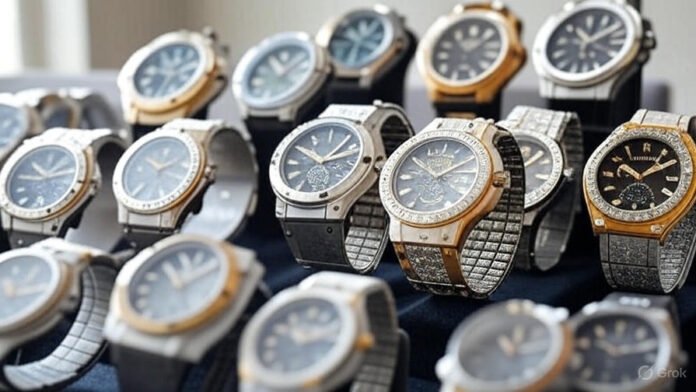The luxury watch industry, long a symbol of craftsmanship and prestige, is facing an escalating challenge: the proliferation of high-quality replicas. Among the brands most affected is Hublot, a Swiss watchmaker renowned for its innovative designs and bold material combinations. As the demand for Hublot watches grows, so does the market for replicas, raising concerns about authenticity, craftsmanship, and the integrity of the luxury market. This article explores the rise of Hublot Replica watches, the challenges they pose, and how consumers can navigate this complex landscape.
The Allure of Hublot Watches
Founded in 1980 by Carlo Crocco, Hublot redefined luxury watchmaking by combining unconventional materials like rubber and gold, creating a distinctive aesthetic that resonated with the elite. The introduction of the Big Bang collection in 2005 further solidified Hublot’s reputation, with its bold designs and innovative use of materials like ceramic, carbon fiber, and sapphire crystal. These timepieces are more than accessories; they are status symbols, often priced in the tens of thousands of dollars, reflecting meticulous engineering and artisanal craftsmanship.
Hublot’s collaborations with artists, athletes, and brands have further elevated its appeal. From partnerships with football organizations to avant-garde designs with creators like Takashi Murakami, Hublot has positioned itself as a leader in modern horology. However, this popularity has made the brand a prime target for counterfeiters, who seek to capitalize on its prestige by producing replicas that mimic its iconic designs.
The Rise of Hublot Replicas
The market for replica watches has surged in recent years, driven by advancements in manufacturing technology and the accessibility of online marketplaces. Hublot Replica watches, in particular, have become increasingly sophisticated, often replicating the brand’s signature aesthetic with remarkable accuracy. These replicas range from low-quality fakes, easily identifiable by their poor craftsmanship, to high-end “super clones” that closely mimic authentic Hublot watches in appearance and weight.
According to industry experts, the demand for replicas stems from the high cost of genuine Hublot watches, which can be prohibitive for many consumers. Replicas offer an affordable alternative, allowing individuals to emulate the luxury aesthetic without the significant financial investment. However, this growing market raises ethical and legal concerns, as replicas often infringe on intellectual property and undermine the craftsmanship that defines brands like Hublot.
Recent reports indicate that the replica market is not only thriving online but also becoming more challenging to regulate. Websites and marketplaces offering “first copy” or “1:1 replica” Hublot watches have proliferated, often marketing their products as high-quality alternatives. These replicas may feature materials like ceramic or stainless steel and even mimic the brand’s signature H-shaped screws, making it difficult for untrained eyes to spot the difference.
Spotting the Difference: Authentic vs. Replica
Distinguishing a genuine Hublot watch from a replica requires careful attention to detail. Experts suggest several key areas to examine when verifying authenticity:
- Movement: Authentic Hublot watches use high-precision Swiss-made movements, often developed in-house or sourced from reputable manufacturers. Replicas typically rely on cheaper, less accurate movements, which may not keep time as reliably.
- Engravings and Text: Genuine Hublot watches feature precise, deeply etched engravings, particularly on the case back and dial. Replicas often have uneven or shallow engravings, with fonts that may not align with the brand’s standards.
- Materials: Hublot is known for its use of premium materials like scratch-resistant sapphire crystal and high-tech ceramics. Replicas may use lower-quality alternatives, such as mineral glass or inferior ceramics, which lack the same durability and finish.
- Weight and Feel: Authentic Hublot watches have a substantial weight due to their high-quality materials. Replicas often feel lighter or less refined, even if they appear visually similar.
- Packaging and Documentation: Genuine Hublot watches come with high-quality packaging, warranty cards, and certificates of authenticity. Replicas may include generic or poorly produced documentation, if any.
For consumers, purchasing from authorized retailers or directly from Hublot is the safest way to ensure authenticity. Reputable dealers, such as those listed on Hublot’s official website, provide guarantees of quality and authenticity, reducing the risk of unknowingly purchasing a replica.
The Ethical and Legal Implications
The production and sale of replica watches, including those mimicking Hublot designs, are illegal in many jurisdictions due to intellectual property violations. These replicas not only infringe on Hublot’s designs but also devalue the craftsmanship and innovation that go into creating authentic timepieces. For consumers, purchasing a replica can carry risks, including potential seizure by customs authorities when importing such items.
Beyond legal concerns, there are ethical considerations. Buying replicas undermines the artisans and engineers who dedicate years to perfecting luxury watches. It also impacts the broader luxury market, as the proliferation of fakes can erode consumer trust in high-end brands. Some argue that replicas democratize luxury, allowing more people to enjoy the aesthetic of high-end watches, but others counter that this practice diminishes the exclusivity and value of genuine craftsmanship.
Consumer Advice: Navigating the Market
For those looking to invest in a Hublot watch, due diligence is essential. Experts recommend researching the seller thoroughly, whether purchasing online or in-store. Authorized retailers and Hublot’s official boutiques are the most reliable sources, offering warranties and after-sales support that replicas cannot match. Additionally, consumers should be wary of deals that seem too good to be true, as significantly discounted Hublot watches are often red flags for counterfeits.
For those who admire Hublot’s aesthetic but cannot afford the price tag, some suggest exploring homage watches—timepieces inspired by luxury designs but sold under different brand names. Unlike replicas, homage watches are legal and often provide a transparent alternative for budget-conscious buyers. However, they lack the prestige and quality of genuine Hublot watches.
The Future of Hublot and the Replica Market
As Hublot continues to innovate, with recent releases like the Big Bang Tourbillon and Classic Fusion Essential Taupe, the brand remains a target for counterfeiters. The company has taken steps to combat replicas, including working with authorities to shut down illegal operations and educating consumers on how to spot fakes. However, the global nature of the replica market, combined with the anonymity of online sales, poses ongoing challenges.
Looking ahead, the luxury watch industry may need to adopt new technologies, such as blockchain-based authentication or advanced serial number tracking, to stay ahead of counterfeiters. For now, consumers play a critical role in preserving the integrity of brands like Hublot by choosing authenticity over imitation.
Conclusion
Hublot’s legacy of innovation and bold design has made it a cornerstone of the luxury watch industry, but its success has also fueled the rise of replicas. While these imitations may offer a superficial resemblance to genuine Hublot watches, they lack the craftsmanship, precision, and heritage that define the brand. By understanding the differences between authentic and replica watches and making informed purchasing decisions, consumers can support the artistry of luxury watchmaking while avoiding the pitfalls of the counterfeit market.












